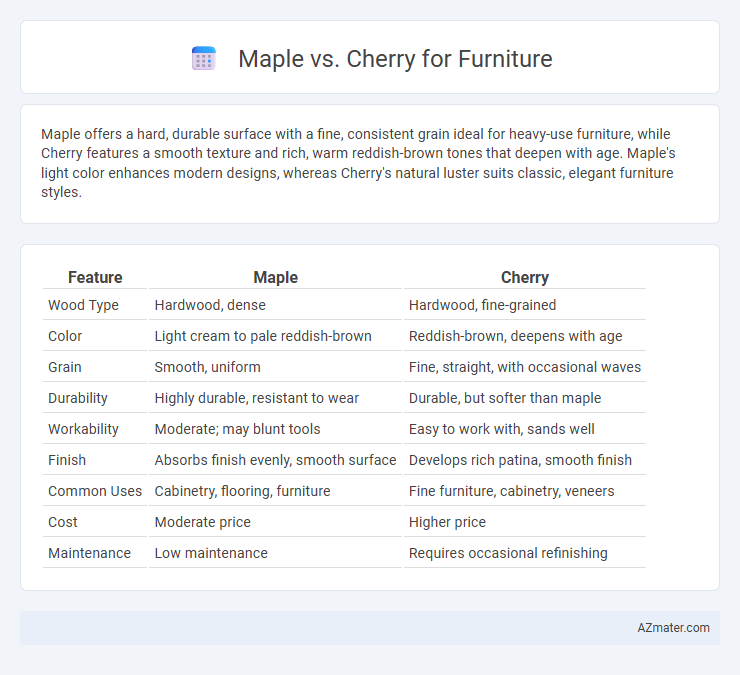Maple offers a hard, durable surface with a fine, consistent grain ideal for heavy-use furniture, while Cherry features a smooth texture and rich, warm reddish-brown tones that deepen with age. Maple's light color enhances modern designs, whereas Cherry's natural luster suits classic, elegant furniture styles.
Table of Comparison
| Feature | Maple | Cherry |
|---|---|---|
| Wood Type | Hardwood, dense | Hardwood, fine-grained |
| Color | Light cream to pale reddish-brown | Reddish-brown, deepens with age |
| Grain | Smooth, uniform | Fine, straight, with occasional waves |
| Durability | Highly durable, resistant to wear | Durable, but softer than maple |
| Workability | Moderate; may blunt tools | Easy to work with, sands well |
| Finish | Absorbs finish evenly, smooth surface | Develops rich patina, smooth finish |
| Common Uses | Cabinetry, flooring, furniture | Fine furniture, cabinetry, veneers |
| Cost | Moderate price | Higher price |
| Maintenance | Low maintenance | Requires occasional refinishing |
Introduction to Maple and Cherry Wood
Maple wood is characterized by its fine, uniform grain and exceptional hardness, making it highly resistant to dents and scratches, ideal for durable furniture pieces. Cherry wood is prized for its rich reddish-brown color that deepens with age and smooth texture, offering a warm, elegant aesthetic. Both hardwoods provide excellent stability and workability, but maple is often favored for modern, light-colored furniture while cherry complements traditional, darker designs.
Appearance and Color Comparison
Maple furniture features a light, creamy color with subtle grain patterns that provide a smooth and consistent appearance, making it ideal for modern and minimalist interiors. Cherry wood shows a rich, reddish-brown hue that deepens over time, offering a warm and elegant look that enhances traditional and classic furniture styles. Both woods offer unique visual appeal, with maple's pale tone brightening spaces and cherry's vibrant color adding depth and sophistication.
Grain Pattern Differences
Maple furniture features a fine, consistent grain pattern with subtle, flowing lines that create a smooth, uniform appearance ideal for contemporary and minimalist designs. Cherry wood displays a rich, pronounced grain with occasional wavy or curly patterns, offering a warm, elegant look favored in traditional and classic styles. The choice between maple and cherry grain patterns influences the furniture's visual texture and ambiance, impacting overall aesthetic and style preference.
Durability and Hardness
Maple and cherry are both popular hardwood choices for furniture, but maple stands out for its superior durability and hardness, ranking around 1450 on the Janka hardness scale compared to cherry's 995. This makes maple highly resistant to dents and scratches, suitable for high-traffic or heavily used furniture. Cherry offers a softer, more pliable texture, which allows for easier carving and a rich, warm patina over time but may show wear more quickly in comparison to maple.
Workability and Machinability
Maple offers excellent workability with its smooth texture and fine grain, making it easy to shape, sand, and finish, ideal for detailed furniture work. Cherry wood also exhibits good machinability but tends to soften quickly, requiring sharp tools and slower feed rates to avoid burn marks during cutting. Both woods respond well to hand and power tools, but maple's hardness means it holds up better for intricate machining without compromising surface quality.
Cost and Availability
Maple furniture is generally more cost-effective due to its abundance and faster growth in North America, making it widely available and affordable for mass production. Cherry wood tends to be more expensive because of its slower growth rate and limited supply, contributing to its status as a premium hardwood in furniture making. Availability of maple exceeds cherry, ensuring more consistent pricing and easier sourcing for manufacturers and consumers alike.
Finishing and Staining Properties
Maple offers a smooth, tight grain that allows for an even finish, making it ideal for staining and creating a uniform color; its dense wood minimizes blotchiness and highlights subtle stain variations. Cherry wood features a fine, straight grain with natural luster that absorbs stains more unevenly, enhancing its rich, warm tones over time and developing a patina that deepens with age. Both woods respond well to finishes, but maple's consistent surface suits high-gloss or clear finishes, while cherry's dynamic grain benefits from oil-based stains that emphasize its natural color changes.
Sustainability and Environmental Impact
Maple furniture is often favored for its sustainability due to the tree's rapid growth and regenerative capacity, making it a renewable resource with a lower environmental footprint. Cherry wood, while prized for its rich color and durability, typically grows more slowly and can contribute to higher ecological strain if not sourced responsibly. Choosing FSC-certified maple or cherry ensures both woods minimize habitat disruption and promote sustainable forestry practices.
Best Uses for Maple vs Cherry Furniture
Maple furniture is best suited for high-traffic areas due to its hardness, durability, and resistance to dents, making it ideal for dining tables and cabinetry. Cherry wood, prized for its rich color and smooth grain, excels in decorative pieces like bedroom furniture and accent chairs where aesthetic appeal is paramount. Choosing maple or cherry depends on the balance between functional wear resistance and elegant appearance required for your specific furniture use.
Choosing the Right Wood for Your Furniture
Maple offers exceptional durability and a smooth, light grain that resists dents and scratches, making it ideal for high-traffic furniture pieces. Cherry provides rich, warm hues and a fine, uniform texture that deepens in color with age, adding timeless elegance to cabinetry and accent furniture. Choosing between maple and cherry depends on whether you prioritize longevity and resilience or aesthetic warmth and patina in your furniture design.

Infographic: Maple vs Cherry for Furniture
 azmater.com
azmater.com